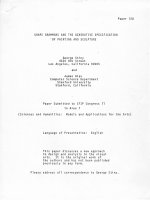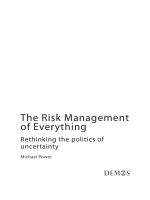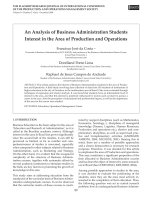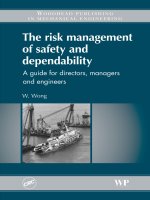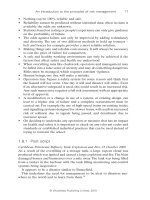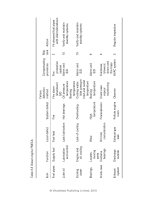The Risk Management of Safety and Dependability_1 pot
Bạn đang xem bản rút gọn của tài liệu. Xem và tải ngay bản đầy đủ của tài liệu tại đây (837.88 KB, 30 trang )
© Woodhead Publishing Limited, 2010
The risk management of safety and dependability
© Woodhead Publishing Limited, 2010
The risk
management of
safety and
dependability
A guide for directors,
managers and engineers
W. Wong
Oxford Cambridge New Delhi
© Woodhead Publishing Limited, 2010
Published by Woodhead Publishing Limited, Abington Hall, Granta Park,
Great Abington, Cambridge CB21 6AH, UK
www.woodheadpublishing.com
Woodhead Publishing India Private Limited, G-2, Vardaan House, 7/28 Ansari
Road, Daryaganj, New Delhi – 110002, India
www.woodheadpublishingindia.com
Published in North America by CRC Press LLC, 6000 Broken Sound Parkway, NW,
Suite 300, Boca Raton, FL 33487, USA
First published 2010, Woodhead Publishing Limited and CRC Press LLC
© Woodhead Publishing Limited, 2010
The author has asserted his moral rights.
This book contains information obtained from authentic and highly regarded
sources. Reprinted material is quoted with permission, and sources are indicated.
Reasonable efforts have been made to publish reliable data and information, but
the author and the publishers cannot assume responsibility for the validity of all
materials. Neither the author nor the publishers, nor anyone else associated with
this publication, shall be liable for any loss, damage or liability directly or
indirectly caused or alleged to be caused by this book.
Neither this book nor any part may be reproduced or transmitted in any form
or by any means, electronic or mechanical, including photocopying, microfi lming
and recording, or by any information storage or retrieval system, without
permission in writing from Woodhead Publishing Limited.
The consent of Woodhead Publishing Limited does not extend to copying for
general distribution, for promotion, for creating new works, or for resale. Specifi c
permission must be obtained in writing from Woodhead Publishing Limited for
such copying.
Trademark notice: Product or corporate names may be trademarks or registered
trademarks, and are used only for identifi cation and explanation, without intent
to infringe.
British Library Cataloguing in Publication Data
A catalogue record for this book is available from the British Library.
Library of Congress Cataloging in Publication Data
A catalog record for this book is available from the Library of Congress.
Woodhead Publishing ISBN 978-1-84569-712-9 (book)
Woodhead Publishing ISBN 978-1-84569-938-3 (e-book)
CRC Press ISBN 978-1-4398-2992-9
CRC Press order number: N10174
The publishers’ policy is to use permanent paper from mills that operate a
sustainable forestry policy, and which has been manufactured from pulp which is
processed using acid-free and elemental chlorine-free practices. Furthermore, the
publishers ensure that the text paper and cover board used have met acceptable
environmental accreditation standards.
Typeset by Toppan Best-set Premedia Limited, Hong Kong
Printed by TJ International Limited, Padstow, Cornwall, UK
© Woodhead Publishing Limited, 2010
Contents
About the author xi
Acknowledgements xii
Preface xiii
1 Ever-present danger: an introduction to the principles
of risk management 1
1.1 Introduction 1
1.2 The principles of risk assessment 2
1.3 The risk assessment matrix 3
1.4 Risk evaluation and control 4
1.5 Dependability 5
1.6 The risk management process 5
1.7 Examples of risk management failures 5
1.8 General precepts 16
1.9 Summary 18
1.10 References 18
2 Ignorance is no defence: legislation and the corporate
role in managing risk 19
2.1 Introduction: management failures 19
2.2 An overview of the law in the UK 21
2.3 The Health and Safety at Work etc. Act 1974 24
2.4 The Management of Health and Safety at Work
Regulations 1999 (MHSWR) 25
2.5 The Provision and Use of Work Equipment Regulations
1998 (PUWER) 26
2.6 The Reporting of Injuries, Diseases and Dangerous
Occurrences Regulations 1995 (RIDDOR) 26
2.7 The Control of Substances Hazardous to Health
Regulations 1994 (COSHH) 27
v
vi Contents
© Woodhead Publishing Limited, 2010
2.8 The Supply of Machinery Safety Regulations 2008
(Machinery Directive 2006/42/EC) 27
2.9 The Electromagnetic Compatibility (Amendment)
Regulations 2006 30
2.10 The Control of Major Accident Hazards Regulations 1999
(COMAH) Amended 2005 31
2.11 The Construction (Design and Management) (CDM)
Regulations 2007 32
2.12 The Dangerous Substances and Explosive Atmospheres
Regulations 2002 (DSEAR) 35
2.13 The Equipment and Protective Systems Intended for Use
in Potentially Explosive Atmospheres Regulations 1996
(SI 1996/192) (ATEX Directive 94/9/EC, as amended 2001) 40
2.14 The Pressure Equipment Directive 1999 (PED) 42
2.15 The Pressure Systems Safety Regulations 2000 43
2.16 The Lifting Operations and Lifting Equipment Regulations
1998 (LOLER) 43
2.17 Other regulations and standards 44
2.18 International health and safety 44
2.19 Summary 45
2.20 References 45
3 How to recognise hazards: learning about generic
industrial hazards 47
3.1 Introduction 47
3.2 Human vulnerability 48
3.3 Hazards from waste emissions 48
3.4 Hazards from heat emissions and hot surfaces 56
3.5 Hazards from noise emissions 56
3.6 Hazards from radiation 62
3.7 Hazards from latent energy 63
3.8 Hazards from other sources 64
3.9 Hazards from design error 69
3.10 Complacency 70
3.11 Summary 71
3.12 References 71
4 Human factors in risk management: understanding
why humans fail and are unreliable 72
4.1 Introduction 72
4.2 Ergonomics 74
4.3 Anthropometrics 85
4.4 Physiology 85
Contents vii
© Woodhead Publishing Limited, 2010
4.5 Psychology 87
4.6 Case histories 89
4.7 Summary 96
4.8 References 96
5 Exposing hazards: techniques to fi nd possible risks
of unacceptable failures in procedures, machines
and systems 98
5.1 Introduction 98
5.2 ‘What if’ procedure 98
5.3 Block fl ow diagrams 101
5.4 Failure mode and effects analysis (FMEA) 105
5.5 Hazard and operability studies (HAZOP) 110
5.6 A cautionary example 117
5.7 Summary 117
5.8 References 118
6 Safe enough? Methods and procedures for
evaluating and reducing risk in the design of
processes, plant and machinery 119
6.1 Introduction 119
6.2 Bow Tie analysis 122
6.3 Human error 124
6.4 Redundancy 128
6.5 Series systems 131
6.6 Reliability 132
6.7 Component failure 132
6.8 Fault tree analysis (FTA) 136
6.9 Pressure control system 136
6.10 Safety integrity level (SIL) 143
6.11 Summary 143
6.12 References 144
7 Inherently unsafe: safety issues in planning
a new facility 145
7.1 Introduction 145
7.2 Site location 145
7.3 Scope considerations 147
7.4 Design for safety 149
7.5 Hazardous area classifi cation 149
7.6 Fire prevention 150
7.7 Design to ensure safety 157
7.8 Design for reliability 160
viii Contents
© Woodhead Publishing Limited, 2010
7.9 Summary 163
7.10 References 164
8 Product risk: managing risk in the design and
development process 165
8.1 Introduction 165
8.2 Product risk assessment 166
8.3 Reliability testing 169
8.4 Life characteristics 169
8.5 Reliability target 173
8.6 Statistical data 176
8.7 Data enhancement 177
8.8 Test data processing 180
8.9 Test data analysis 183
8.10 Warranty analysis 185
8.11 Summary 186
8.12 References 187
9 Asset integrity: learning about the cause and
symptoms of age and decay and the need for
maintenance to avoid catastrophic failures 188
9.1 Introduction 188
9.2 Maintenance strategies 190
9.3 Failure due to service deterioration 194
9.4 Failures due to corrosion 205
9.5 Pressure systems failures 210
9.6 Risk-based inspection (RBI) 213
9.7 Maintenance resources 221
9.8 Summary 222
9.9 References 225
10 Coping with risk: how to ensure the health and
safety of people at work 226
10.1 Introduction 226
10.2 The cost of safety and reliability 227
10.3 The occupational safety and health
management system 228
10.4 Education and training 232
10.5 Supervision 233
10.6 Control 234
10.7 Monitoring performance 239
10.8 Emergency planning and management 240
10.9 Plant modifi cation: change procedures 245
Contents ix
© Woodhead Publishing Limited, 2010
10.10 Auditing safety 248
10.11 Security 251
10.12 Summary 251
10.13 References 252
11 Management disasters: the lessons to be learnt
from three major disasters 253
11.1 Introduction 253
11.2 Bhopal 254
11.3 Piper Alpha 258
11.4 Nimrod 268
11.5 Summary 272
11.6 References 273
Appendix 1: List of abbreviations and acronyms 275
Appendix 2: Bibliography 279
Appendix 3: Directory of bodies associated with risk
management and safety 281
Index 287
© Woodhead Publishing Limited, 2010
About the author
William Wong was a visiting lecturer on safety and reliability at University
College London from 1994 to 2008. He retired after 25 years at Bechtel in
1999 and has held many positions in industry, up to management level,
fulfi lling many different roles as a professional engineer for over half a
century. He has worked on a wide range of projects: in the design and
construction of North Sea platforms, a fl oating production vessel, petro-
chemical plants, LNG plants, power stations, gas and oil transmission pipe-
lines, air separation cryogenic plants and a wind tunnel. In his early years
he worked in manufacturing. He worked in the aerospace industry on
engine development, and then in the oil industry on the design, manufactur-
ing and testing of gas turbines and process gas compressors.
xi
© Woodhead Publishing Limited, 2010
Acknowledgements
This book has originated from the book How did that happen? published
in 2002. It has mostly been rewritten to refl ect the developments and
changes in the EU regulations since that time. It could not have been
written without experience gained from teaching the subject at University
College London to students from a modern generation that is ignorant of
engineering concepts, emphasising the need to make the subject easy to
understand.
I would like to acknowledge the help from:
Bechtel Ltd for part-time secondment to UCL as a visiting lecturer up until
my retirement.
Members of the present IMechE Safety and Reliability Group for their
helpful comments: R. Denning, N. Stewart, J. Lewis, R. May, C. Vaughan.
Philip Highe for updating the notes on radiation.
Liz Brueck of Health and Safety Laboratories for help in updating the notes
on noise.
Mike McCarthy of Reliasoft for help with Weibull analysis and data
processing.
Dr Jian-Zong Zhang for his help on metallurgy.
Reliasoft Corporation for the use of software for producing the life char-
acteristic graphs.
Professor Strutt for his advice on extending the contents of the book.
Professors R. Bea and J. Bray for permission to use material from their
report on the New Orleans Flood disaster.
Smit International for the photo of the Herald of Free Enterprise.
Hertfordshire Fire & Rescue Service for the photo of Buncefi eld.
Professor S. Richardson, Imperial College, for the photos (copyright
unknown) and his notes on Piper Alpha.
Roland Pruessner, GE Power Systems, Essen, Germany for providing
examples of computer control screens.
R. Flood and J. Wilkinson for proof reading and comments.
HMSO for the picture of the Nimrod XV230 (Charles Haddon-Cave QC
(2009), The Nimrod Report, HMSO, London. ISBN 978010296265. Crown
Copyright).
xii
© Woodhead Publishing Limited, 2010
Preface
In this modern world people live and work in a man-made jungle sur-
rounded by dangers unseen and unheard. The complexity of this world is
ever increasing as man builds more and more facilities to counter the effects
of global warming, increasing and ageing populations and the need for
sustainability. Once in a while disaster strikes and people wonder, how did
that happen? So often it happens because a number of seemingly unimport-
ant events happen to coincide. It may appear that it is because of someone’s
mistake. However when all the facts are known, ignorance, bad manage-
ment and poor engineering are also to blame.
Unlike Little Red Riding Hood, people need to be made aware of and
kept alert to the dangers that may face them. Laws and regulations are
enacted to protect the health and safety of people with measures to mini-
mise the risks to life and limb. These matters are the responsibility of direc-
tors, managers, engineers and safety practitioners, but everyone has a role
to play.
It is important to understand the relationship between reliability, avail-
ability, maintainability and safety; that nothing is perfect, and that age and
decay must be recognised so that ill effects can be prevented before they
occur. Because of this, people, engineered systems and devices need man-
agement attention to ensure their dependability.
This book has been written for the benefi t of all as a guide to these
matters. It provides a comprehensive introduction to all the basic principles
that can be applied across all industries. It is intended to assist the mission
of the Health and Safety Executive, and to further that of the Safety and
Reliability Group of the IMechE, in ensuring a safer world. It exceeds the
recommended syllabus on the subject by the Hazards Forum (the inter
institutional group on health and safety established by the Institutions of:
Civil Engineers, Mechanical Engineers, Engineering Technology, and
Chemical Engineers) and follows the guidelines issued by The Engineering
Council.
William Wong
xiii
© Woodhead Publishing Limited, 2010
1
1
Ever-present danger: an introduction to the
principles of risk management
Abstract: People live with a constant risk of disaster. This chapter
explains how risks are managed by risk assessment, risk evaluation and
taking measures to control risk. These measures have to be dependable
to be effective, as measured by their reliability, maintainability and
availability. All these matters are part of the process of managing
risk and these concepts are explained in simple terms with easy to
understand examples from real life disasters. Some guidance on general
precepts is given to underline the principles involved.
Key words: risk, assessment, evaluation, control, process, management
failures, New Orleans, space shuttle, Railtrack, Buncefi eld, air collision,
general precepts.
1.1 Introduction
In the 21st century more and more people live and work in a man-made
environment. They depend on engineering and the application of science
and technology for housing, electrical and gas supplies, water supplies, the
processing of sewage and refuse, transport, communications, the produc-
tion of raw materials, and even the way food is produced. The effects of
global warming, the need to reduce carbon dioxide (CO
2
) emissions and
the rising world population will intensify this situation. They already under-
stand the impact on the environment due to the use of hydrocarbon fuels
for transportation and the generation of electricity. People need to under-
stand the risks to their health and safety.
The dependability of public services is usually taken for granted, and that
all needs will be fulfi lled as and when required. However, the ever-present
dangers that people live under are mostly unseen and unheard until disaster
strikes. But, once in a while, the public are shocked out of their compla-
cency with industrial disasters that affect whole towns and communities.
For example the railway accidents that occurred in the United Kingdom
(UK) during the years 1998–2008, with many dead and injured, had an
immediate effect and resulted in a complete reorganisation of the railway
infrastructure and management.
2 The risk management of safety and dependability
© Woodhead Publishing Limited, 2010
Concern over industrial accidents and the pollution from its waste and
emissions has resulted in legal requirements that have now extended to every
situation to protect the health and safety of workers and the general public.
Over the years it has become recognised that the duty of care has to be a
team effort that extends up to senior management. In recognition of this, the
UK in 2007 established the criminal offence of corporate manslaughter and
corporate homicide to deal with failings in risk management. In risk manage-
ment the initiating action required is that of risk assessment.
1.2 The principles of risk assessment
An approach suitable for assessing risk in the work place is a fi ve-step
procedure:
1
• Identify the hazards.
• Decide who might be harmed and how.
• Evaluate the risks and decide on precautions.
• Record the fi ndings and implement them.
• Review the assessment and update as necessary.
However, the general principle of risk assessment in industry
2
is based on
the key elements as follows:
• Identifying hazards, which have a potential for harm.
• Risk is defi ned as the probability that a hazardous event could occur.
• Consequence is the harm resulting from a hazardous event occurring.
• Risk assessment is the consideration of risk and the consequences of a
hazardous event in order to decide if any action is necessary to avoid or
to reduce the risk.
• Record the results of the risk assessment and the action taken.
These are very simple concepts to put in place and yet a doctor was heard
to say that if she were to worry about risk nothing would ever be done. A
headmaster thought that risks should be avoided by cancelling all school
excursions. These attitudes, which are all too prevalent, completely miss the
point. People need to stop, and think of what could go wrong, and think of
measures that will help to prevent those that are unacceptable from
happening.
Every time someone crosses a busy road they make a risk assessment. If
they are elderly and cannot move very fast they wait until there is no traffi c.
Younger people will assess the speed and distance of the oncoming traffi c,
to judge if they can safely cross. Once in a while a young man jogging across
a common, runs out across a major road without stopping to make a risk
assessment and gets killed by oncoming traffi c; people need to stop and
think.
An introduction to the principles of risk management 3
© Woodhead Publishing Limited, 2010
In industry there are many complex situations that need to be managed,
for these a risk matrix is useful as a qualitative method for conducting a risk
assessment to determine its acceptability. Typically this risk assessment
process is carried out by a team of multi-discipline engineers and can also
involve specialist engineers for more complex situations. The views of each
team member and the collective judgement in reaching decisions are essen-
tial to ensure all risks are fully understood and recognised.
1.3 The risk assessment matrix
The risk assessment matrix is carried out by formulating a severity level table
and a likelihood table so that the selection of the value from the two then
provides the risk ranking, which gives an indication of its acceptability.
1.3.1 Severity level
The severity level table can be used for many different situations and the
level criteria formulated to suit. For example if it is to do with physical
danger to a person it could be based on the level of injury. Table 1.1 shows
a typical severity level table.
1.3.2 Likelihood
Table 1.2 shows a typical likelihood table. This shows four levels but
sometimes using fi ve may be more appropriate depending on the
circumstances.
Table 1.1 Severity level
Class Level Defi nition (any one or more)
1 Serious In-plant fatality; public fatalities; extensive property
damage; serious and long-term environmental
damage; 2 or more days extended downtime
2 High Lost time injury; public injuries or impact; signifi cant
property damage; environmental impact exceeding
regulation standards; downtime of 1–2 days
3 Medium Minor injury; moderate property damage; minimum
short-term environmental damage; 4–24 hours
downtime; disruption of product quality
4 Low No worker injuries; minor property damage; no
environmental impact; downtime less than 4 hours
5 Minor No worker injuries, property damage or environmental
impact; recoverable operational problem
4 The risk management of safety and dependability
© Woodhead Publishing Limited, 2010
Ranking matrix
Risk ranking is a qualitative assessment that depends on the experience
and judgement of the assessor.
A risk ranking matrix is shown in Table 1.3.
1.4 Risk evaluation and control
Following the assessment, evaluation can be made as to its acceptability. If
unacceptable, decisions can then be made on whether the risk can either
be eliminated or controlled.
1.4.1 Risk control
Risks can be controlled through management processes or the use of hard-
ware solutions (such as fi re protection systems). In addition there may be
Table 1.2 Likelihood level
Class Level Frequency of occurrence
1 Frequent Potential to occur frequently (many times a year)
2 Occasional Potential to occur occasionally (once a year)
3 Moderate Potential to occur under unusual circumstances (once
or twice in facility lifetime)
4 Unlikely Could possibly occur, or known to occur within the
same industry, but not likely to occur over the
facility lifetime
Table 1.3 Risk ranking matrix
Likelihood
Severity level
123 4 5
112345
2246810
3 3 8 9 12 15
4 48121620
Notes:
A rank of 1 signifi es the most dangerous risk.
A rank of 20 is an acceptable risk.
The shaded area shows rankings from 12 to 20; usually considered acceptable,
needing no action.
An introduction to the principles of risk management 5
© Woodhead Publishing Limited, 2010
applicable codes, standards or established industrial practices available.
There are also Health and Safety Executive (HSE) guidelines that target
specifi c industries and safety critical operations. The European Union (EU)
has produced a raft of regulations enacted by the UK parliament that
address the need to ensure safety in the design of products and the design,
construction and operation of plant, equipment and machinery. There is a
legal duty for corporate management to comply with these regulations, with
the HSE and the Environment Agency available to provide guidance when
required. It is also important to ensure that any measures taken to reduce
any risk are dependable.
1.5 Dependability
Dependability is defi ned as the ability to meet success criteria, under given
conditions of use and maintenance. It is affected by the attributes of reli-
ability, maintainability and availability. For example the risk to life and limb
as a result of an accident or emergency can be reduced by the speed it
takes for the victims to be rushed to a hospital. People depend on the
emergency ambulance service to fulfi l this function. If an ambulance breaks
down, the availability of the service is reduced by the period it takes for
the maintenance work needed to return the ambulance into service.
However, if a backup is there to take the place of the failed ambulance,
then the availability of an ambulance is unaffected and the service is
dependable. The backup or spare ambulance is kept idle until an ambu-
lance breaks down and so it is said to be redundant. This is costly but is
needed to ensure a reliable service; a point often overlooked by manage-
ment when they want to cut costs.
1.6 The risk management process
Risk management is a continuous process where measures to control risk
are regularly audited to ensure that they are in place, and functioning as
prescribed. Circumstances may change and result in the emergence of new
hazards, or existing risks may be affected. If so, they must be subjected to
a risk assessment and evaluated for further action as necessary. If things
remain unchanged, strong leadership is required to avoid any onset of
complacency. Effective risk management depends on constant vigilance.
This is illustrated by Fig. 1.1.
1.7 Examples of risk management failures
The following examples serve to highlight some different aspects of risk
management failure, which illustrate the foregoing issues.
6 The risk management of safety and dependability
© Woodhead Publishing Limited, 2010
1.7.1 The New Orleans disaster
On 25 August 2005 a hurricane developed over the Atlantic and a warning
was given to New Orleans of its coming. With increasing force it made
landfall by 29August. It hit New Orleans with a storm surge (see Fig. 1.2)
and by 31 August a major disaster had occurred. Most of the city was under
fl ood water and hundreds were feared to have died. The fi nal offi cial death
toll for New Orleans and Southern Louisiana was 1293, with 300 missing
and unaccounted for so the true fi gure may never be known. The fi nancial
loss was expected to be between US$100 and 200 billion. New Orleans has
been described as a walled city surrounded by water; most of it is below
sea level and a complex drainage system with 20 pumping stations is needed
to keep it dry. The city is sandwiched by the Mississippi River on one side
and by Lake Pontchartrain on the other side. Channels passing through the
city to enable navigation and discharge of drainage waters connect the river
and the lake. The river and the drainage channels are above sea level, so
Review codes and
standards / industrial
practices
Amend as required
Monitor and audit
Dependability and
safety integrity level
requirements
Risk management
process
Identify hazards
Risk assessment
Risk evaluation
Consider options
Implement selected
option
Operations
Report
1.1 Risk management process.
An introduction to the principles of risk management 7
© Woodhead Publishing Limited, 2010
they all have levees and fl ood walls to prevent water fl ooding back into the
city.
New Orleans was fl ooded in 1965, after which a Flood Control Act was
passed authorising the construction of fl ood defences, to be completed by
1978. However, due to repeated cuts in the budget, the required fl ood
defences were still only partially completed by 2005. In the previous year
the engineers who were charged with the maintenance of the facilities had
their request for funds for repair works drastically cut. It has been claimed
that even if the works were completed, the fl ood would still have occurred,
as the tidal wave would still have overfl owed the levees.
Subsequent investigation has shown that the storm surges produced by
Hurricane Katrina resulted in numerous breaches and consequent fl ooding
of approximately 75% of metropolitan New Orleans.
3
Overtopping caused
most of the levee and fl ood wall failures. As the storm surge rose over the
tops of the levees and fl ood walls, the water overfl ow caused erosion of the
footings, which subsequently led to the failures and breaches. As the storm
died, the fl ood waters that remained in the city could not be pumped out
because many of the pumping stations had failed. Figure 1.3 shows a map
of the east side of the city, which faced the brunt of the hurricane, and shows
the damage caused to the fl ood control defences.
1.2 Hurricane Katrina tidal wave (source unknown).
8 The risk management of safety and dependability
© Woodhead Publishing Limited, 2010
The root cause of the disaster
The disaster was due to the failure to manage the risk of disaster to the
city. The hazard of possible fl ooding was known, as the city is below sea
level. The probability that fl ooding would reoccur can be assessed based
on:
• The city had been fl ooded in 1915, 1940, 1947, 1965 and 1969.
• The risk to communities along the Gulf Coast from a hurricane is recog-
nised and a national agency is charged with tracking all hurricanes that
develop over the Atlantic. They are required to give an early warning
to a community to evacuate should there be a threat of an approaching
hurricane.
• The Gulf of Mexico suffers from hurricanes every 10 years and records
show that about every 40 years they make landfall at New Orleans, and
are strong enough to cause fl ooding.
Levee Breaches
Pumping Stations
Flood Status
Storm Induced
Deliberate
Closed
Greater Than 90% Capacity
40% to 90% Capacity
Less Then 40% Capacity
Under Assessment
Dry
Not Dry
Lake Pontchartrain
Lake Borgne
N
ew
Orleans East
New Orleans East
St. Bern
ar
d
Pari
s
h
Belle Chasse #2
Belle Chasse #1
Scarsdale
Braithwaite
Belair
Bellevue
W - 3b
W - 4b
W - 3a
W - 4a
1.3 Map showing where Hurricane Katrina hit New Orleans and the
damage to the fl ood defences (source: Report No UCB/CITRIS – 05/01
17 November 2005; ref 1.3).
An introduction to the principles of risk management 9
© Woodhead Publishing Limited, 2010
• The sea level is increasing due to global warming, and hurricanes are
likely to be more prevalent and destructive.
• The city is subsiding.
An assessment was made after the last fl ood and fl ood defences were autho-
rised. However, regular reassessments are required for changing circum-
stances in order to be able to update the evaluation of the consequences
should fl ooding occur, especially as the city has grown over the years since
1965. Changing circumstances will also change the nature of the defences
needed. In addition, structures age and deteriorate over time and need
regular inspection and maintenance. The disaster occurred because the
fl ood defences were not dependable; they were breached at 50 locations
and failed due to inadequate maintenance and enhancement to meet chang-
ing circumstances. Many failed due to the use of erodible materials of
construction. This, together with the large sections of uncompleted levees,
resulted in the disaster.
4
Conclusion
Over the years the authorities consistently cut the budget for the building
of fl ood defences. They even cut the budget on maintenance. The engineers
asked for US$62 million for maintenance works in 2005 but this was cut to
US$10 million. Furthermore the design standard of the levee system as
established originally was that suitable for land protection. As the city grew,
a risk assessment of the adequacy of the design standard was never under-
taken. The fi nal report recommended that the whole organisation for the
risk management of the New Orleans fl ood defences should be changed. A
new management structure with new design standards and regulations, and
adequate funding was needed to avoid a further disaster. This demonstrates
that in any organisation the management of risk is a critical function to
ensure that the appropriate measures are taken to avoid them. When
nothing adverse happens year after year management become complacent
and decide to spend their money on what they consider to be more pressing
matters. Complacency has been the cause of many disasters.
1.7.2 The space shuttle disaster
Following the success of the United States (US) lunar missions, the technol-
ogy was then used to build and place objects in orbit around the earth for
commercial and scientifi c use. Figure 1.4 shows a space shuttle lift-off. In
spite of the success of the lunar programme, and after 14 successful mis-
sions, on Tuesday 28 January 1986 the Challenger II space shuttle exploded
10 The risk management of safety and dependability
© Woodhead Publishing Limited, 2010
soon after take-off. All the crew including a civilian schoolteacher died in
the disaster.
5
The space shuttle had two solid fuel booster rockets fi tted each side of
the main fuel tank. The body of the rocket was made up of 3.65 m diameter
cylinders with one detachable socket joint sealed with ‘O’ rings. When the
rockets were fi red for lift-off some smoke was noted to be momentarily
coming from a joint. After lift-off a fl ame was seen and soon afterwards the
fuel tank exploded.
The root cause of the disaster
The ‘O’ ring seals of the rocket engines were known to suffer blowby. As
the rocket engines are jettisoned into the sea some time after lift-off, and
are recovered for reuse, it was possible to inspect the ‘O’ ring seals after-
wards. It was found that the discharge of smoke seen on lift-off was due to
blowby and erosion of the ‘O’ ring seal. Correlation of when blowby (the
1.4 Space shuttle lift-off (courtesy of NASA).
An introduction to the principles of risk management 11
© Woodhead Publishing Limited, 2010
discharge of smoke) was found and the ambient conditions on lift-off
showed that they occurred every time at temperatures below 18 °C. Those
above 18 °C were mostly trouble free. The lowest temperature recorded at
the time was a lift-off at a temperature of 12 °C. Based on this the rocket
engineers informed the National Aeronautics and Space Administration
(NASA) management that lift-off should not take place at ambient tem-
peratures below 12 °C. Management rejected this restriction. Their decision
was based on the fact that nothing had ever gone wrong. Blowby had hap-
pened many times without ill effect so why should they worry?
The political demands on its schedule, together with fi nancial concerns,
led to the risk of failure being ignored. Challenger II lifted off when
the ambient temperature was below freezing and disaster was the result.
It transpired that the NASA management somehow thought that the
shuttle was so reliable that there was only one in a hundred thousand
chance of a mishap. The engineers involved, however, put it at one in a
few hundred. There was a lack of rapport between the engineers and the
management.
Conclusion
The management lived in a world dominated by politics and the need to
obtain public support for the funding of their operations. They lost contact
with engineering and the need for safety and reliability. It is quite common
for people to think things are safe before disaster happens; whereas in
reality nothing is safe until it is proven to be safe. The engineers knew that
the discharge of smoke indicated incipient failure of the ‘O’ ring and that
this was affected by temperature. As blowby was increasingly experienced
down towards 12 °C, they feared a catastrophic seal failure would occur at
some lower temperature. Maybe they were loath to voice the worst; if the
managers were more responsive, perhaps they would have done. Funds
could have been authorised to test the effects of lower temperatures on seal
performance. Investigation into the cause of the disaster concluded that the
management structure of NASA had to be overhauled so that adequate
systems were in place to ensure the safety and dependability of their
operations.
Comment
Engineers are rightly concerned about the consequences of failure and like
to measure the probability of its occurrence. It is too common for manage-
ment to think everything is safe because nothing has gone wrong. Unfor-
tunately it is the low cost, easy option that they so often prefer.
